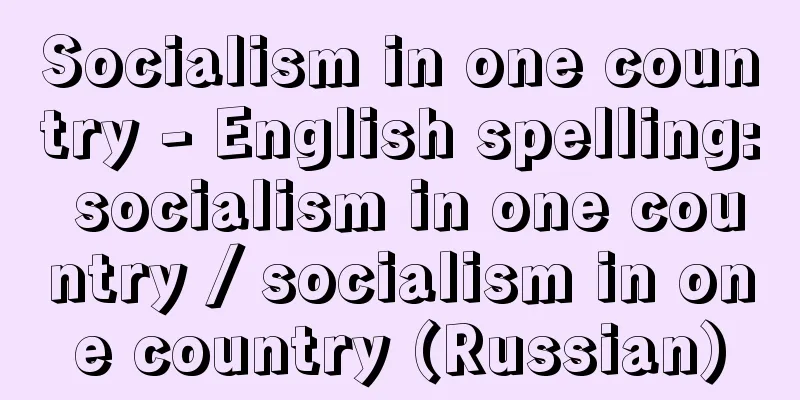Socialism in one country - English spelling: socialism in one country / socialism in one country (Russian)

|
The Stalin-Bukharin faction's argument in the debate over the direction of socialist construction that took place in the Soviet Union after the victory of the Russian Revolution was that it was possible to build socialism in one country. The leaders of the Bolshevik Party (Lenin, Trotsky, etc.), who led the Russian Revolution to victory, had hoped that the revolution would immediately spread to Germany and the rest of Europe, creating a world revolution. In reality, however, only Russia was able to win under the revolutionary circumstances after World War I. Therefore, after the defeat of the German workers' uprising in 1923 and the death of Lenin in January 1924, an important point of contention within the Communist Party of the Soviet Union was how quickly the revolution in Russia, a backward country that had originally begun as part of a world revolution, should be led to global socialism. In this debate, Trotsky advocated the "permanent revolution theory," which argued that the construction of socialism in the Soviet Union could not be victorious without the victory and support of the Western European proletariat. Stalin, Bukharin and others distinguished between "socialist construction" and the "total victory of socialism," arguing that the latter was impossible for one country alone but the former was possible, and thus ousted and exiled the Trotskyites. This theory combined Lenin's theory of uneven development with Lenin's desire to maintain the Soviet state, which he was forced to do in his later years due to the defeat of the Western European revolution, but Stalin universalized it as the doctrine of "Marxism-Leninism," and in the actual construction process, he pushed ahead with industrialization and agricultural collectivization at a forced march pace that ignored the claims of Bukharin and others, and in 1934 he proclaimed the "triumph of socialism." The "construction of socialism" debated here was based solely on economistic thinking, with the objectives of nationalizing the means of production and establishing a centrally planned economy, and ignored issues of human liberation for the working class and political democracy. Furthermore, because it sought to maintain and secure a victorious proletarian government and build a bridgehead for a long-term world revolution, this theory led people to see the Soviet Union as the "homeland of the proletariat," and also served to rationalize Stalin's purges. The Eastern European Revolution of 1989 and the collapse of the Soviet Union in 1991 made clear the political nature and theoretical limitations of this debate itself. [Tetsuro Kato] [Reference] |Source: Shogakukan Encyclopedia Nipponica About Encyclopedia Nipponica Information | Legend |
|
ロシア革命勝利後、ソ連において行われた、社会主義建設をめぐる路線論争におけるスターリン‐ブハーリン派の主張で、一国社会主義建設可能論のこと。ロシア革命を勝利に導いたボリシェビキ党の指導者たち(レーニン、トロツキーら)は、革命がただちにドイツおよび全ヨーロッパへと飛び火し広がる世界革命を期待していたが、現実には、第一次世界大戦後の革命的情勢のもとで勝利しえたのはロシア一国のみであったため、1923年のドイツ労働者蜂起の敗北と24年1月のレーニンの死後、ソ連共産党内では、もともと世界革命の一環として開始された後進国ロシアの革命を、どのようなテンポで世界的な社会主義へと導いていくかが重要な論争点とされた。この論争でトロツキーは、西欧プロレタリアートの勝利と支持がなければソ連の社会主義建設は勝利しえないとする「永続革命論」を唱えた。スターリン、ブハーリンらは、「社会主義建設」と「社会主義の完全な勝利」を区別し、後者は一国のみでは不可能であるが前者は可能であるとして、トロツキー派を失脚させ、追放した。この理論は、レーニンの不均等発展論と、レーニン晩年の西欧革命の敗北により余儀なくされたソビエト国家維持の志向とを結び付けたものであったが、スターリンはこれを「マルクス・レーニン主義」の教義として普遍化し、しかも現実の建設過程では、ブハーリンらの主張を排除した強行軍的テンポでの工業化と農業集団化を強引に推し進め、1934年には「社会主義の勝利」を宣言していった。 ここで論争された「社会主義建設」とは、もっぱら生産手段の国有化と中央集権的計画経済樹立を指標とした経済主義的思考に依拠したもので、労働者階級の人間的解放や政治的民主主義の問題を捨象したものであった。また、勝利したプロレタリア政権を維持・確保し長期にわたる世界革命への橋頭堡(きょうとうほ)を築いてゆくという理由で、この理論はソ連を「プロレタリアートの祖国」と観念させ、スターリンの粛清を合理化する機能をも果たした。1989年の東欧革命、91年のソ連崩壊で、この論争そのものの政治的性格と理論的限界が明らかになった。 [加藤哲郎] [参照項目] |出典 小学館 日本大百科全書(ニッポニカ)日本大百科全書(ニッポニカ)について 情報 | 凡例 |
<<: National average role - Ikkoku Heikinyaku
>>: One Country, One Castle Law - Ikkokuichijorei
Recommend
Puzzle - Puzzle
[Daily necessities] The university brand of Meisei...
The Post-Dispatch
In 1968, he joined the German newspaper "Ves...
Tragopan caboti (English spelling)
…[Ryozo Kakizawa]. … *Some of the terminology tha...
Onibofura - Onibofura
→K Source: Shogakukan Encyclopedia Nipponica Abou...
Liberal Unionist Party (English spelling)
A British political party. It was founded in 1886...
《One Stop》 - Isshiki
...Although there are some missing years, the boo...
Wall-type reinforced concrete structure
...There are examples of high-rise buildings over...
Wallace Line - Wallace Center
The boundary line of biological distribution that ...
Staatsoper Wien (English spelling)
However, there are still no opera houses like tho...
Kiriko - Kiriko
A cube with each corner cut off. 2. (Abbreviation ...
Eight Banners of the Han Dynasty
One of the Eight Banners (military system) of the ...
Aitubo - Aitubo
It was also written as "Aio Tsubo" and w...
Hansan Island
An island located on the southern coast of Gyeong...
Issengiri - One-sen-kiri
Punishment in the Azuchi-Momoyama period. This wo...
Eclipse year - Shokunen (English spelling)
The period between the passage of the Sun through ...









